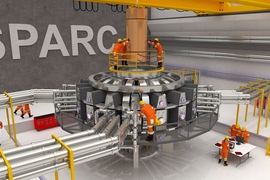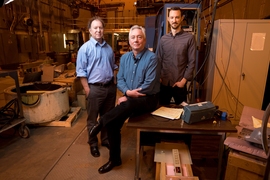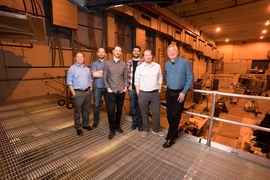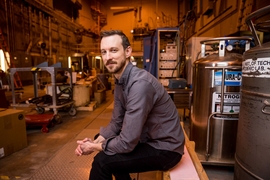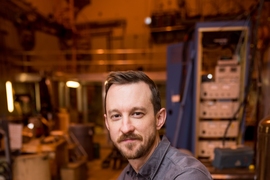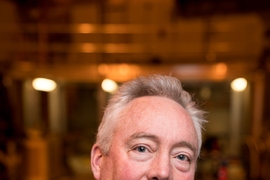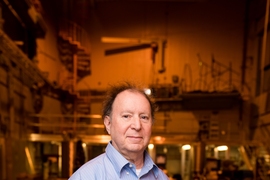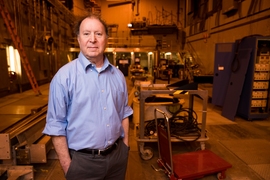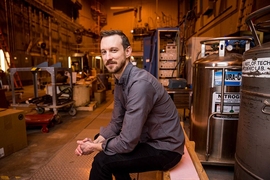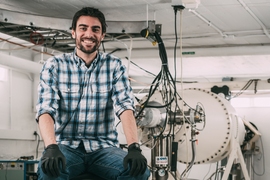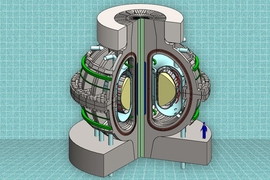Progress toward the long-sought dream of fusion power — potentially an inexhaustible and zero-carbon source of energy — could be about to take a dramatic leap forward.
Development of this carbon-free, combustion-free source of energy is now on a faster track toward realization, thanks to a collaboration between MIT and a new private company, Commonwealth Fusion Systems. CFS will join with MIT to carry out rapid, staged research leading to a new generation of fusion experiments and power plants based on advances in high-temperature superconductors — work made possible by decades of federal government funding for basic research.
CFS is announcing today that it has attracted an investment of $50 million in support of this effort from the Italian energy company Eni. In addition, CFS continues to seek the support of additional investors. CFS will fund fusion research at MIT as part of this collaboration, with an ultimate goal of rapidly commercializing fusion energy and establishing a new industry.
“This is an important historical moment: Advances in superconducting magnets have put fusion energy potentially within reach, offering the prospect of a safe, carbon-free energy future,” says MIT President L. Rafael Reif. “As humanity confronts the rising risks of climate disruption, I am thrilled that MIT is joining with industrial allies, both longstanding and new, to run full-speed toward this transformative vision for our shared future on Earth.”
“Everyone agrees on the eventual impact and the commercial potential of fusion power, but then the question is: How do you get there?” adds Commonwealth Fusion Systems CEO Robert Mumgaard SM ’15, PhD ’15. “We get there by leveraging the science that’s already developed, collaborating with the right partners, and tackling the problems step by step.”
MIT Vice President for Research Maria Zuber, who has written an op-ed on the importance of this news that appears in today’s Boston Globe, notes that MIT’s collaboration with CFS required concerted effort among people and offices at MIT that support innovation: “We are grateful for the MIT team that worked tirelessly to form this collaboration. Associate Provost Karen Gleason’s leadership was instrumental — as was the creativity, diligence, and care of the Office of the General Counsel, the Office of Sponsored Programs, the Technology Licensing Office, and the MIT Energy Initiative. A great job by all.”
Superconducting magnets are key
Fusion, the process that powers the sun and stars, involves light elements, such as hydrogen, smashing together to form heavier elements, such as helium — releasing prodigious amounts of energy in the process. This process produces net energy only at extreme temperatures of hundreds of millions of degrees Celsius, too hot for any solid material to withstand. To get around that, fusion researchers use magnetic fields to hold in place the hot plasma — a kind of gaseous soup of subatomic particles — keeping it from coming into contact with any part of the donut-shaped chamber.
The new effort aims to build a compact device capable of generating 100 million watts, or 100 megawatts (MW), of fusion power. This device will, if all goes according to plan, demonstrate key technical milestones needed to ultimately achieve a full-scale prototype of a fusion power plant that could set the world on a path to low-carbon energy. If widely disseminated, such fusion power plants could meet a substantial fraction of the world’s growing energy needs while drastically curbing the greenhouse gas emissions that are causing global climate change.
“Today is a very important day for us,” says Eni CEO Claudio Descalzi. “Thanks to this agreement, Eni takes a significant step forward toward the development of alternative energy sources with an ever-lower environmental impact. Fusion is the true energy source of the future, as it is completely sustainable, does not release emissions or long-term waste, and is potentially inexhaustible. It is a goal that we are increasingly determined to reach quickly.”
CFS will support more than $30 million of MIT research over the next three years through investments by Eni and others. This work will aim to develop the world’s most powerful large-bore superconducting electromagnets — the key component that will enable construction of a much more compact version of a fusion device called a tokamak. The magnets, based on a superconducting material that has only recently become available commercially, will produce a magnetic field four times as strong as that employed in any existing fusion experiment, enabling a more than tenfold increase in the power produced by a tokamak of a given size.
Conceived at PSFC
The project was conceived by researchers from MIT’s Plasma Science and Fusion Center, led by PSFC Director Dennis Whyte, Deputy Director Martin Greenwald, and a team that grew to include representatives from across MIT, involving disciplines from engineering to physics to architecture to economics. The core PSFC team included Mumgaard, Dan Brunner PhD ’13, and Brandon Sorbom PhD ’17 — all now leading CFS — as well as Zach Hartwig PhD ’14, now an assistant professor of nuclear science and engineering at MIT.
Once the superconducting electromagnets are developed by researchers at MIT and CFS — expected to occur within three years — MIT and CFS will design and build a compact and powerful fusion experiment, called SPARC, using those magnets. The experiment will be used for what is expected to be a final round of research enabling design of the world’s first commercial power-producing fusion plants.
SPARC is designed to produce about 100 MW of heat. While it will not turn that heat into electricity, it will produce, in pulses of about 10 seconds, as much power as is used by a small city. That output would be more than twice the power used to heat the plasma, achieving the ultimate technical milestone: positive net energy from fusion.
This demonstration would establish that a new power plant of about twice SPARC’s diameter, capable of producing commercially viable net power output, could go ahead toward final design and construction. Such a plant would become the world’s first true fusion power plant, with a capacity of 200 MW of electricity, comparable to that of most modern commercial electric power plants. At that point, its implementation could proceed rapidly and with little risk, and such power plants could be demonstrated within 15 years, say Whyte, Greenwald, and Hartwig.
Complementary to ITER
The project is expected to complement the research planned for a large international collaboration called ITER, currently under construction as the world’s largest fusion experiment at a site in southern France. If successful, ITER is expected to begin producing fusion energy around 2035.
“Fusion is way too important for only one track,” says Greenwald, who is a senior research scientist at PSFC.
By using magnets made from the newly available superconducting material — a steel tape coated with a compound called yttrium-barium-copper oxide (YBCO) — SPARC is designed to produce a fusion power output about a fifth that of ITER, but in a device that is only about 1/65 the volume, Hartwig says. The ultimate benefit of the YBCO tape, he adds, is that it drastically reduces the cost, timeline, and organizational complexity required to build net fusion energy devices, enabling new players and new approaches to fusion energy at university and private company scale.
The way these high-field magnets slash the size of plants needed to achieve a given level of power has repercussions that reverberate through every aspect of the design. Components that would otherwise be so large that they would have to be manufactured on-site could instead be factory-built and trucked in; ancillary systems for cooling and other functions would all be scaled back proportionately; and the total cost and time for design and construction would be drastically reduced.
“What you’re looking for is power production technologies that are going to play nicely within the mix that’s going to be integrated on the grid in 10 to 20 years,” Hartwig says. “The grid right now is moving away from these two- or three-gigawatt monolithic coal or fission power plants. The range of a large fraction of power production facilities in the U.S. is now is in the 100 to 500 megawatt range. Your technology has to be amenable with what sells to compete robustly in a brutal marketplace.”
Because the magnets are the key technology for the new fusion reactor, and because their development carries the greatest uncertainties, Whyte explains, work on the magnets will be the initial three-year phase of the project — building upon the strong foundation of federally funded research conducted at MIT and elsewhere. Once the magnet technology is proven, the next step of designing the SPARC tokamak is based on a relatively straightforward evolution from existing tokamak experiments, he says.
“By putting the magnet development up front,” says Whyte, the Hitachi America Professor of Engineering and head of MIT’s Department of Nuclear Science and Engineering, “we think that this gives you a really solid answer in three years, and gives you a great amount of confidence moving forward that you’re giving yourself the best possible chance of answering the key question, which is: Can you make net energy from a magnetically confined plasma?”
The research project aims to leverage the scientific knowledge and expertise built up over decades of government-funded research — including MIT’s work, from 1971 to 2016, with its Alcator C-Mod experiment, as well as its predecessors — in combination with the intensity of a well-funded startup company. Whyte, Greenwald, and Hartwig say that this approach could greatly shorten the time to bring fusion technology to the marketplace — while there’s still time for fusion to make a real difference in climate change.
MITEI participation
Commonwealth Fusion Systems is a private company and will join the MIT Energy Initiative (MITEI) as part of a new university-industry partnership built to carry out this plan. The collaboration between MITEI and CFS is expected to bolster MIT research and teaching on the science of fusion, while at the same time building a strong industrial partner that ultimately could be positioned to bring fusion power to real-world use.
“MITEI has created a new membership specifically for energy startups, and CFS is the first company to become a member through this new program,” says MITEI Director Robert Armstrong, the Chevron Professor of Chemical Engineering at MIT. “In addition to providing access to the significant resources and capabilities of the Institute, the membership is designed to expose startups to incumbent energy companies and their vast knowledge of the energy system. It was through their engagement with MITEI that Eni, one of MITEI’s founding members, became aware of SPARC’s tremendous potential for revolutionizing the energy system.”
Energy startups often require significant research funding to further their technology to the point where new clean energy solutions can be brought to market. Traditional forms of early-stage funding are often incompatible with the long lead times and capital intensity that are well-known to energy investors.
“Because of the nature of the conditions required to produce fusion reactions, you have to start at scale,” Greenwald says. “That’s why this kind of academic-industry collaboration was essential to enable the technology to move forward quickly. This is not like three engineers building a new app in a garage.”
Most of the initial round of funding from CFS will support collaborative research and development at MIT to demonstrate the new superconducting magnets. The team is confident that the magnets can be successfully developed to meet the needs of the task. Still, Greenwald adds, “that doesn’t mean it’s a trivial task,” and it will require substantial work by a large team of researchers. But, he points out, others have built magnets using this material, for other purposes, which had twice the magnetic field strength that will be required for this reactor. Though these high-field magnets were small, they do validate the basic feasibility of the concept.
In addition to its support of CFS, Eni has also announced an agreement with MITEI to fund fusion research projects run out of PSFC’s Laboratory for Innovation in Fusion Technologies. The expected investment in these research projects amounts to about $2 million in the coming years.
“Conservative physics”
SPARC is an evolution of a tokamak design that has been studied and refined for decades. This included work at MIT that began in the 1970s, led by professors Bruno Coppi and Ron Parker, who developed the kind of high-magnetic-field fusion experiments that have been operated at MIT ever since, setting numerous fusion records.
“Our strategy is to use conservative physics, based on decades of work at MIT and elsewhere,” Greenwald says. “If SPARC does achieve its expected performance, my sense is that’s sort of a Kitty Hawk moment for fusion, by robustly demonstrating net power, in a device that scales to a real power plant.”
